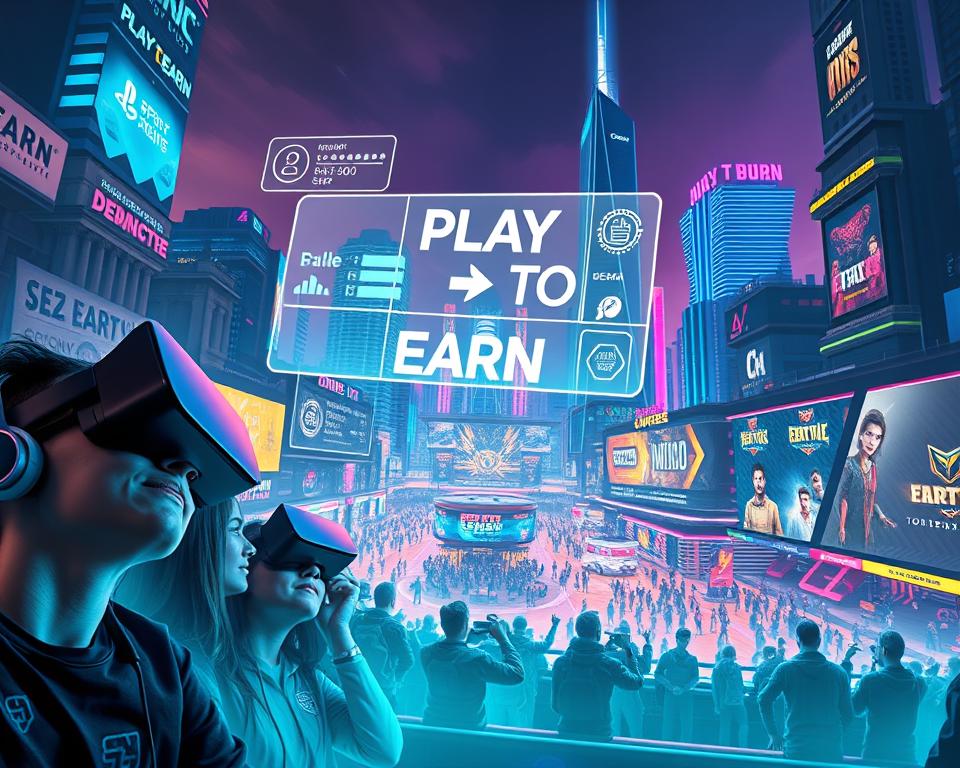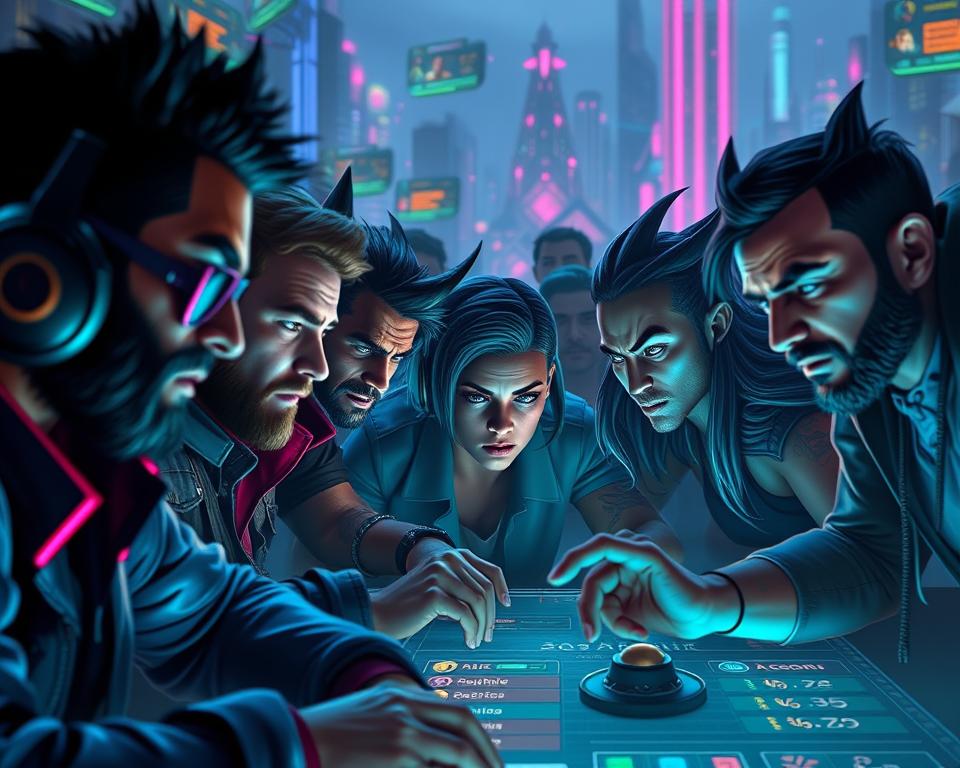Anúncios
Play2Earn 2025 shifts how you think about play, ownership, and value in games — but how real is the promise that you can play, earn, and truly own digital items?
Start simple: you’ll learn why player-owned items matter and how NFTs and smart contracts prove provenance and make on-chain trading safer. This section sets the context so you can compare platforms without hype.
Many titles mix free-to-play access with optional starter buy-ins. You can join some games with no upfront cost, while others unlock more features after acquiring a starter asset. We’ll point out what to check first: wallet setup, chain fees, and contract verification.
Stay cautious and practical. We’ll preview standout games and platforms, explain token mechanics, and show safe setup steps so you can explore with less friction. For a curated list and game notes, see this guide on blockchain titles: best blockchain games.
Introduction to Play2Earn 2025: why the next wave matters for you
The next wave of games hands players clearer paths to earn tokens and own scarce digital items. You can expect rewards delivered as fungible tokens or NFTs for quests, battles, staking, or trades. Smart contracts automate payouts and record provenance so transfers are transparent.
What “play, earn, own” really means: you play titles that issue on-chain rewards, and you truly hold items that can be traded, transferred, or used across supported ecosystems. Ownership does not guarantee profit; tokens are volatile and rewards vary by design and market conditions.
How this Product Roundup helps you compare tools and examples
This roundup breaks down gameplay hooks, reward mechanics, and creator tools so you can match a game to your time and goals. We flag trade-offs: competitive modes often require higher skill or hours to earn more, while casual games focus on collecting and social play.
- Networks: examples run on Ethereum, Solana, and BNB Chain with smart contracts enforcing trades.
- Access: free access vs. buy-in affects your first session and marketplace exposure.
- Safety: we point to official links and verified contracts to help you start safer.
The P2E landscape in 2025: updated context, risks, and opportunities
Player-owned items and token systems have matured, but volatility and design still shape who benefits most. NFTs give verified provenance and cleaner trading history, while in-game tokens power upgrades, crafting, and marketplace pricing.
How rewards form: many games fund payouts from player transactions and economic activity. That pool can swell with demand or shrink when activity drops, so earnings vary by time, skill, and market conditions.
- Watch for red flags: vague white papers, unlimited emissions, and aggressive APY claims that rely on new buyers.
- Macro shifts help and hurt: wider wallet adoption and cheaper L2s lower friction but also attract copycats and quick launches.
- Stabilizers matter: liquidity, burning sinks (crafting costs, upgrade fees), and measured emissions help reduce wild swings.
Practical tips: diversify your play across a few titles, follow patch notes, and track on-chain metrics rather than headlines. Your best edge is informed testing and cautious position sizing.
How Play-to-Earn games work today
When a game mints your character as a token, you gain a clear path to use, trade, or sell it. Assets like characters, items, and land can be NFTs or fungible tokens that live in your wallet. That separation is what lets you move value outside a single game ecosystem.
Tokenized assets, on-chain markets, and smart contracts
Your wallet holds item tokens and currencies, enabling use in-game and trades on marketplaces. In-game shops often coexist with external NFT markets and DEXs, where prices reflect rarity, utility, and demand.
Smart contracts verify ownership, automate transfers, enforce royalties, and reduce counterparty risk when you trade.
Quests, PvP, staking, and creator tools that drive rewards
Typical earning flows include completing quests, winning PvP, crafting and selling items, or renting assets to others. Some ecosystems add staking and governance rewards for long-term participation.
- You’ll see how emissions create tokens and sinks (crafting fees, burning) remove them.
- Creator tools—map editors, mod kits, and asset stores—let you build and monetize content.
- Checklist: confirm official URLs, verify contracts, and start small to learn how a game’s economy works.
Your starter toolkit: wallets, chains, and safe setup
A simple starter setup helps you join games quickly while protecting your crypto and minimizing surprise costs.
Choose a wallet
Compare top picks by chain: MetaMask for EVM chains (Ethereum, Polygon), Phantom for Solana, Trust Wallet for BNB Chain, and Coinbase Wallet for multi-chain ease.
Funding and fee basics
Buy a small amount of ETH, SOL, or BNB on an exchange and transfer it to your wallet. Keep a buffer for gas so you can accept transactions or buy assets without delays.
Gas fees rise with network congestion. Batch actions, use L2s, or wait for lower traffic to save costs.
Security basics and verification
Verify smart contracts on explorers like Etherscan before approving. Revoke allowances that look risky and avoid blind signing.
- Step-by-step safety: bookmark official links, enable phishing alerts, and use a hardware device for larger balances.
- Segment wallets: keep a play wallet with small funds and cold storage for larger holdings.
- Join official Discords to confirm links and ask for support before you click.
Quick checklist: choose the right wallet for your platform, fund small amounts, learn gas patterns, verify contracts, and split risk across wallets so players and users stay safer while exploring new games.
Acquiring in-game assets: free-to-play vs. buy-in
Your choice to join free or pay to enter affects rewards, risk, and the marketplaces you’ll use.
When you need NFTs, when you don’t
Many games offer a free start with limited rewards and core loops you can learn without spending. These modes are great for testing gameplay and mechanics.
Paid entry often uses an nft as a gate. Owning the token can unlock full progression, better rewards, or unique utility like stat boosts and exclusive access.
Some crypto games mix both: free accounts earn slowly, while buy-in players access higher reward paths or marketplace liquidity.
Marketplace choices: native storefronts and external NFT markets
Pricing depends on rarity tiers, attributes, and real demand. Check floor prices, recent sales, and item traits before you buy.
- Native storefronts are integrated and curated on the platform, so listings may be safer and easier to filter.
- External markets often offer broader liquidity and more listings, but verify contract addresses and fees first.
- Look into rentals or scholarship programs to lower upfront costs before players buy full ownership.
Quick buy flow: verify official links, confirm the contract address, check marketplace fees, and review trait history. Never assume purchases will let you make money—tokens and nft prices are volatile, so pace your spend and test small.
Top trends shaping Play2Earn in 2025
A cluster of tech trends is changing which games reward your time and how you move assets. These shifts are practical: they aim to lower costs, boost retention, and make cross-game ownership more useful.
AI-driven design: dynamic quests and adaptive gameplay
AI powers dynamic quests, personalized NPCs, and match-making that keeps sessions fresh. That improves engagement, but it can also raise content testing needs and moderation work.
Mobile-first experiences
More gaming sessions happen on phones. Mobile UX cuts onboarding friction and helps you play on-the-go.
Trade-off: mobile clients may limit advanced features found on desktop.
Cross-chain assets and bridges
Protocols like LayerZero and Wormhole let you move items across chains and platforms. This increases liquidity and access to markets.
Be cautious: bridges add attack surface. Ask for bridge audits and multisig controls before you move funds.
Gasless L2s and subsidized transactions
L2s such as Arbitrum, zkSync, and Immutable X lower fees or offer gasless UX. That cuts friction for new players.
Sustainability matters—subsidies can end, so check fee models and limits.
NFT staking and yield mechanics
NFT staking can add utility and passive rewards for holders. Watch for long lockups, emissions pressure, and central controls that affect value.
- Quick checks: which chain, bridge audit, fee model, and staking terms?
- Mix trends: AI quests + mobile + cross-chain often drive better discovery and retention.
- Test small: try earn games with low cost before committing.
Product Roundup: standout games and platforms to explore
Below are compact profiles of titles that mix battle, building, racing, and mobile movement with on-chain mechanics.
Axie Infinity: Origins
What it does best: strategy-first PvP battles and layered token loops.
How you interact: collect axies, build teams, and compete in ranked play. Caution: watch token emissions and match costs.
Gods Unchained
What it does best: skill-based TCG with ranked rewards.
How you interact: free-to-play entry, card ownership, and GODS token paths. Caution: card markets shift with meta changes.
The Sandbox
What it does best: creator tools and LAND monetization for builders.
How you interact: design experiences, sell assets, and earn SAND rewards as a creator. Caution: quality and discoverability affect returns.
Big Time
What it does best: action RPG loot-as-NFTs and fluid marketplace listings.
How you interact: run dungeons, claim loot, and trade items. Caution: liquidity can change across seasons.
- Illuvium: auto-battler with ILV incentives and strategic team building.
- My Pet Hooligan: PvP shooter with tradable items and fast matches.
- Zed Run: racing and breeding where strategy affects horse value.
- Star Atlas: Solana MMO in progress—features and timelines evolve.
- CryptoBlades: lightweight RPG with SKILL rewards for short sessions.
- MOBOX: aggregator platform with multi-game staking options.
- STEPN: GPS-based move-to-earn sneakers and activity tracking.
Quick note: for each title, check official links, recent patch notes, and marketplace data before you commit time or assets.
Ownership, trading, and safety: what NFTs change in gameplay
When items live on-chain, you gain clear proof of ownership that traditional games rarely provide. That record helps you prove provenance, track past sales, and confirm authenticity before you buy.
True ownership, transferability, and verified provenance
NFTs register item history on the blockchain, so you and other players can verify who minted, sold, or modified an item.
This makes it easier to value a token by checking rarity, past sales, and utility. Still, “ownership” depends on how a game integrates those tokens into play.
Smoother asset transfer and safe trading on-chain
Smart contracts confirm ownership before a transfer. That reduces disputes and lets marketplaces and DEXs support direct trades without middlemen.
- Verify contract addresses and use audited marketplaces; avoid blind signing.
- Review creator royalties and check recent sales to gauge value of in-game assets.
- Choose custody wisely: keep small amounts in hot wallets and larger holdings in hardware wallets.
Practical tip: confirm links via official communities, keep seed phrases offline, and split assets to limit risk. Doing this protects your digital assets and improves your overall gaming experience.
Tokenomics essentials: in-game vs. governance tokens
A game’s token setup often splits duties between spending and decision-making.
Simple split: one token powers upgrades, crafting, and purchase flows. The other lets holders vote on governance and roadmap choices. This dual approach helps separate day-to-day play from long-term protocol decisions.
Utility, sinks, and emissions that affect your experience
Emissions are how tokens enter circulation. Sinks remove tokens—examples include crafting fees, repair costs, and tournament entry. Good design balances these to limit inflation and keep prices meaningful.
DAO voting and why governance matters to players
Governance votes let you influence priorities like tokenomics changes, feature rollouts, and treasury use. Vesting schedules and lockups shape circulating supply and affect how proposals succeed.
- Ask first: supply cap, reward sources, and burn mechanics?
- Track governance forums to prep for votes that change rewards.
- Remember: rewards mirror ecosystem health and can change with updates.
Cross-chain momentum: why interoperability is a 2025 must-have
Interoperability now shapes which games you can play and where your items actually live. Supporting multiple chains helps you chase lower fees, faster finality, or a specific platform’s features without losing ownership of your digital assets.
Using assets across Ethereum, Solana, Polygon, and beyond
How bridges work: most games use bridges or routing protocols to lock an item on one chain and mint a counterpart on another. That enables cross-chain trades and shared inventories, but it also creates extra attack surface.
- Chain trade-offs: Ethereum mainnet offers security but higher fees; L2s and Polygon cut costs; Solana gives low-latency UX.
- Token standards: differing NFT and token formats affect compatibility. Verify that a game’s standard supports the target chain before you move assets.
- Player tips: test with small transfers, confirm official bridging portals, and check bridge audits and track records.
Quick checklist: fees, finality time, explorer verification, and recovery procedures. Track integrations and park assets where they match your weekly game habits to balance liquidity and security in this frontier cycle.
Case in point: Sorare’s migration path to Solana
Sorare is moving assets from StarkEx to Solana via a four-phase process that runs automatically and requires no action from you. The goal is to lower friction so your cards and marketplace activity transfer smoothly while the platform upgrades underlying rails.
Four-phase move from StarkEx to Solana and what it enables
The migration unfolds in four staged steps that handle asset custody, minting, and routing behind the scenes. Each phase is designed to keep assets live on the platform as the swap completes.
Key practical points:
- The process is automatic and minimizes user approvals or manual transfers.
- Phased rollout limits operational risk and keeps marketplace listings stable as the migration proceeds.
- Developers and creators can plan integrations around progressive feature releases rather than a single cutover.
Interoperability, new features, and potential ecosystem growth
Solana’s throughput and ecosystem tools can enable more interoperable experiences across games and marketplaces. That may simplify composability for third-party tools and broaden partnership options.
What to watch: follow official updates for exact timing, feature rollouts, and any governance or token announcements. Monitor post-migration performance and marketplace behavior before changing trading or creator strategies.
Earnings realities: time, skill, market conditions
Earnings in crypto games hinge on how much time you invest, your skill level, and shifting market demand.
Keep expectations grounded. Rewards vary widely across titles and modes. Some systems favor top players and tournament winners. Others give modest payouts for casual play.
Market moves can change the dollar value of a token or reward in minutes or hours ago. That means on-chain rewards are volatile even when you perform well.
- Time vs. skill: PvP ladders and events reward practice and ranking; creator economies reward quality and demand.
- Net costs matter: track fees, asset depreciation, and marketplace cuts against any earnings.
- Pacing tips: start small, test modes, and scale only when the loop fits your schedule.
- Diversify time: spread play across a few titles to avoid dependency on one economy.
- Watch signals: active devs, esports, and healthy secondary markets help but don’t guarantee returns.
Bottom line: treat rewards as variable and experimental. Track results, guard capital, and avoid assuming past earnings predict future outcomes.
Quests, tournaments, and creator economies: practical examples
Competitive events and creator storefronts provide concrete earning options that fit different play styles. You can combine short daily tasks with larger tournaments or creator work to match your schedule and risk appetite.
Completing quests and events for tokenized rewards
Daily and seasonal quests structure repeatable tasks that pay tokens or item drops. For example, many crypto games give small token payouts for login streaks and larger rewards for weekly objectives.
Before you join: verify event rules, prize distribution, and official links in the game’s Discord or website.
Building, renting, and selling in-game assets
You can mint cosmetics, build levels, or list items on marketplaces like The Sandbox or external NFT markets. Rental models let owners lend costly NFTs and split earnings via smart contracts.
- Confirm trait clarity and price history before listing.
- Check contract addresses and tournament legitimacy prior to entry.
- Track ROI in time, not just token value, and watch patch notes for meta shifts.
Staying safe: avoiding scams, rug pulls, and risky mechanics
False airdrops and copycat sites target new players, so treat unexpected offers with skepticism.
Verify any link through official channels and check contract addresses on explorers before you connect a wallet. Look at past transactions to spot sudden large transfers or strange approvals that happened hours ago.
Watch for rug-pull signs: opaque treasury wallets, unaudited contracts, and admin keys with sweeping powers. If a project emphasizes how to “make money” more than gameplay, step back and research.
- Quick scam checklist for users: ignore DM links, decline unsolicited airdrops, and avoid lookalike domains.
- Use a hardware device for storage and keep a separate hot wallet for small in-game actions.
- Revoke token approvals regularly and never share seed phrases with anyone.
Start small: test deposits and withdrawals, document your steps, and follow verified announcements. These habits help players and traders keep crypto and digital items safer while exploring new games.
Play2Earn 2025: what to watch next and how to stay updated
Keep a close eye on official roadmaps to spot when a platform adds gasless onboarding, L2 moves, or cross-chain features. Roadmaps and patch notes show planned features and timing so you can plan testing and budgeting.

Join official communities on Discord and Twitter for verified links, support, and early notices. Read blog posts, changelogs, and GitHub commits to confirm the cadence and transparency of teams.
Evaluate launches responsibly: check chain choice, audits, emissions, sinks, and team transparency before you commit funds. Look for clear withdrawal paths and marketplace flows so you can cash out when a title goes live.
- Start small in a new game and test market listings, trades, and withdrawals.
- Monitor governance proposals that could change token rewards or fees.
- Document your steps and results so you avoid repeated errors and scale only what works.
Final tip: follow official sources, verify contracts, and pilot with a small wallet. Consistent, cautious experimentation beats chasing headlines and helps you learn which crypto games and gaming platforms last through the frontier cycle.
Conclusion
Conclusion
Before you commit time or funds, focus on small tests, verified contracts, and community signals. You’ve seen how play earn systems blend ownership, rewards, and creator tools across chains. Cross-chain assets, AI-driven quests, and gasless L2s shape how crypto games deliver gameplay and value.
You know to set up wallets safely, test bridges with tiny transfers, and verify addresses before signing. Compare loops—battles, quests, building, or racing—and layer in tokenomics when choosing earn games.
Remember: no title guarantees returns. Check official channels, read patch notes, and follow dev updates for Star Atlas or Big Time. Explore responsibly, use this roundup to short-list the best play options, and adjust as the frontier cycle evolves.



